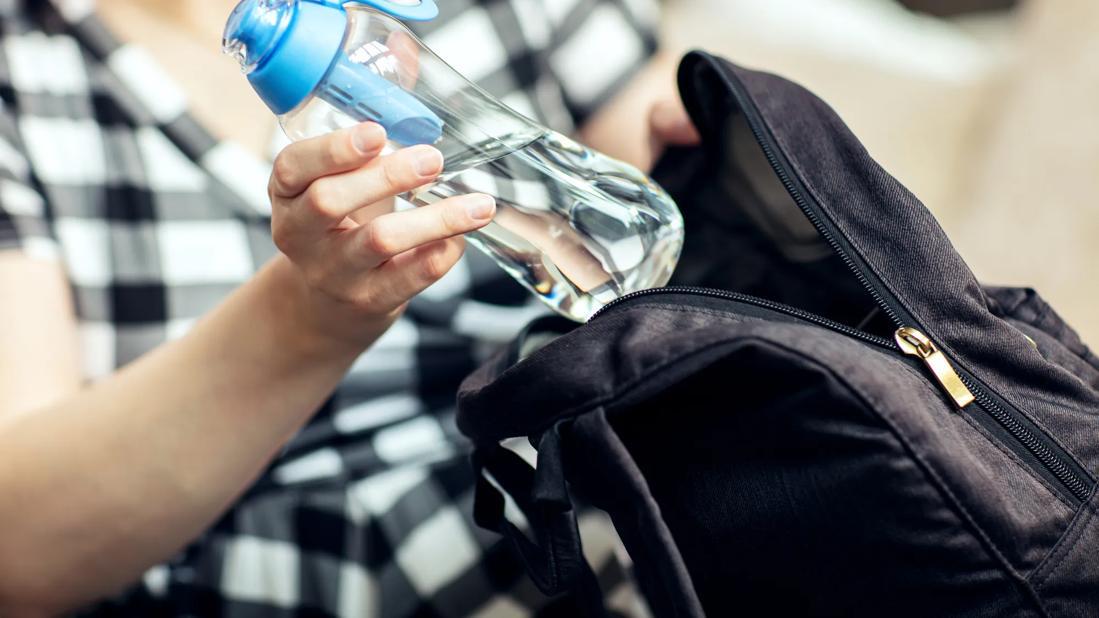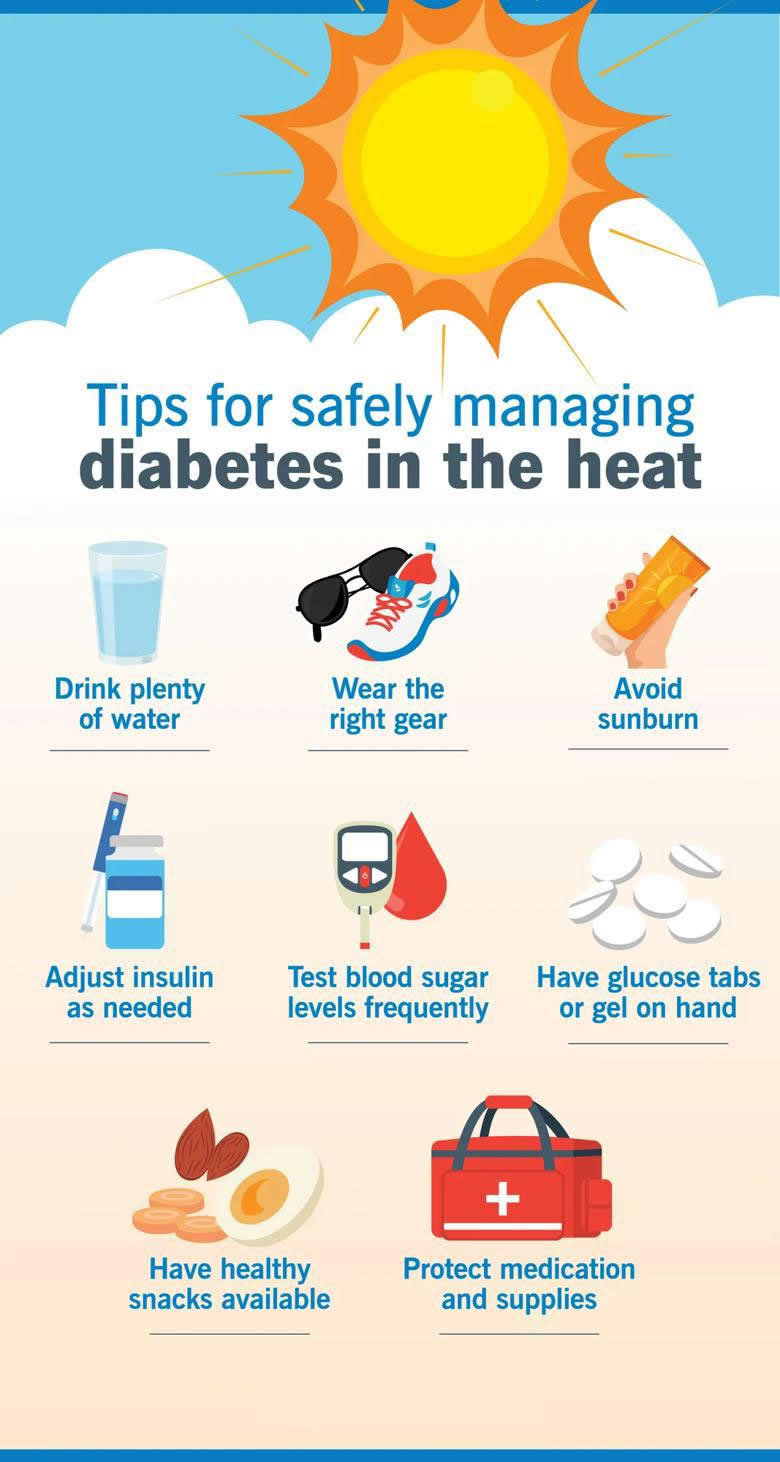The Heat Is On: How To Manage Your Diabetes During Extreme Temps
Hot, humid weather can affect your blood sugar levels and even cause dehydration or heat stroke

If you have diabetes, heat can affect your blood sugar — especially if you use insulin or your blood sugars aren’t effectively managed.
For example, your level of activity in the heat may increase your risk for low blood sugar (hypoglycemia) or high blood sugar (hyperglycemia).
That’s why endocrinologist Marwan Hamaty, MD, says it’s important to get a handle on your blood sugar before you engage in summer fun.
How heat affects people with diabetes
Hot weather may affect your blood sugar levels depending on:
- What you’ve eaten
- Whether you’re well-hydrated
- Your activity level
“If your blood sugars are mostly higher than 250 mg/dl, I recommend improving your blood sugar before engaging in heavy physical activity, regardless of the climate and the temperature,” says Dr. Hamaty.
Humidity can also play a role. Moist heat means your sweat takes longer to evaporate and can cause your body to work harder to cool you off.
Here’s how the heat can affect you:
It may cause low or high blood sugar
Physical activity usually causes blood sugar levels to decrease, reducing your need for insulin. But exercising in the heat may also cause your blood sugar levels to rise.
Dr. Hamaty says this means you should take extra precautions and monitor your sugar levels before exercising.
“I advise my patients to adjust their insulin dosage prior to engaging in physical activity because insulin adjustment could vary significantly, if not managed properly,” he notes.
He also suggests seeking input from your doctor, regardless of the temperature, before adding physical activity to your routine.
It may lead to dehydration
If the heat and your activity make you sweat a lot, you may become dehydrated, leading to a rise in glucose levels. So, adequate hydration is crucial.
“If you become dehydrated, your blood glucose levels will rise,” explains Dr. Hamaty. “This can lead to frequent urination, which then leads to further dehydration and even higher blood sugar levels — a kind of vicious cycle.”
Things can become even worse if you manage your diabetes with insulin.
“Dehydration reduces blood supply to your skin and, therefore, reduces your body’s ability to absorb the insulin you’ve injected,” he adds.
If you’ve had complications from diabetes that have damaged the nerves to your sweat glands, you may be unable to sweat properly. This can become serious as outdoor temperatures rise, leading to heat exhaustion and heat stroke.
It may damage your diabetes medication and equipment
Extreme temperatures can also damage your medications and testing equipment.
Most types of insulin can tolerate temperatures up to 93 to 95 degrees Fahrenheit (33.9 to 35 degrees Celsius). Exposing your supply to anything higher than this will make the medication quickly break down. Be careful and pay attention to any insulin you’re carrying with you in the heat.
And while it’s fine to store insulin and glucagon in the refrigerator, extreme heat (as well as freezing temperatures) will cause the medications to degrade, making them ineffective and unusable.
High temperatures can have a negative impact on other medications and diabetes management supplies. Don’t forget about the weather’s effect on things like test strips and monitoring devices. When the mercury begins to rise, these items can change in their effectiveness.
“You need to protect yourself and your supplies during both winter and summer,” states Dr. Hamaty.
Safety tips for diabetes and heat

“You can participate in outdoor activities and enjoy all types of weather as long as you take a few precautions,” says Dr. Hamaty.
Follow these tips to help manage your diabetes while enjoying the outdoors:
- Drink plenty of water. Staying hydrated is important for everyone during physical activity, and it’s especially critical if you have diabetes.
- Avoid becoming dehydrated. Carry small bottles of water or low-calorie electrolyte-replenishing sports drinks in a backpack or on a belt while you’re hiking or playing sports.
- Wear the right gear. Opt for loose-fitting clothing that’s lightweight and light-colored. Choose breathable natural fabrics like cotton instead of synthetic materials like spandex.
- Avoid sunburn. You can get sunburned while skiing on the slopes or while hiking in the summer. Sunburn stresses your body and can raise blood sugar levels. Use a broad-spectrum sunscreen and wear a hat and sunglasses.
- Adjust your insulin as needed. Ask your healthcare provider or diabetes educator how you should adjust your insulin (or even carbs) before exercising in the heat.
- Test your blood sugar levels frequently. As hot temperatures can cause blood sugar levels to fluctuate, it’s a good idea to test more often. You should continue frequent monitoring for several hours after you’re done with your workout or other activity. That’s because the effects of activities on blood sugars usually last for a longer period of time. If you’re on insulin, using a continuous glucose monitor is a great idea, along with using the test strips to verify blood sugar readings when needed.
- Keep items to treat low blood sugar with you. This includes glucose tabs or glucose gel. If you’re at high risk for very low blood sugar (if you have frequent low blood sugar or have had very low blood sugar previously), you should also have a glucagon kit available.
- Take some healthy snacks with you. Some snacks can serve as a meal replacement, while others help prevent low blood sugar. Discuss possible options with your dietitian.
- Protect your medication and supplies. Take proactive steps to protect your diabetes medications and other supplies before you head outdoors, regardless of the temperature. Consider a car cooler that plugs into a 12-volt car adapter to keep your supplies at the proper temperature. If you’re going away from your car for an extended period, you’ll need to take your supplies along with you. If you’re on an insulin pump, be sure to protect it from high temperatures.
Bottom line? Pay attention to the weather
Diabetes doesn’t have to sideline you from fun outdoor activities. You may just need to find the right time of day to enjoy summer (or another time of year).
“While I advise staying active during the peak winter or summer months, I also tell people to try to take advantage of outdoor activities when temperatures aren’t too extreme,” says Dr. Hamaty. “By taking a few precautions, you can enjoy an active, healthy lifestyle in most any weather.”